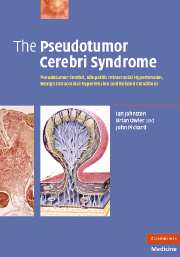 The Pseudotumor Cerebri Syndrome
The Pseudotumor Cerebri Syndrome Published online by Cambridge University Press: 21 August 2009
Introduction
The clinical features of PTCS are well-established and largely uncontroversial, unlike, for example, the issues pertaining to disease mechanism and treatment. Thus, there are now several epidemiological studies which provide sound information on the incidence of the syndrome in the general population as well as some indication of differences in geographically different populations. These studies also confirm the quite distinctive age and sex distribution patterns of PTCS which are apparent in clinical studies. Likewise, the symptoms and signs of PTCS are well-established. Thus, the four most common symptoms are headache, nausea and vomiting, disturbances of visual function, and diplopia, whilst the four most common signs are papilloedema, reduction of visual acuity, restriction of visual fields, and VIth nerve palsy.
There are, however, notable if infrequent variations in the ‘standard’ clinical presentation which clinicians need to be aware of. These involve the absence of one or more of the four main symptoms and absence of one or more of the four main signs. Less commonly, there is the presence of additional symptoms and/or signs. Also, there are to some extent variations in the nature of the clinical presentation in children and, to a lesser extent, in men which should be recognized. In this chapter, after reviewing the epidemiology, the nature, frequency, and duration of the clinical signs will be considered, followed by identification of some of the atypical presentations, and finally, a consideration of issues relating to differential diagnosis.
To save this book to your Kindle, first ensure [email protected] is added to your Approved Personal Document E-mail List under your Personal Document Settings on the Manage Your Content and Devices page of your Amazon account. Then enter the ‘name’ part of your Kindle email address below. Find out more about saving to your Kindle.
Note you can select to save to either the @free.kindle.com or @kindle.com variations. ‘@free.kindle.com’ emails are free but can only be saved to your device when it is connected to wi-fi. ‘@kindle.com’ emails can be delivered even when you are not connected to wi-fi, but note that service fees apply.
Find out more about the Kindle Personal Document Service.
To save content items to your account, please confirm that you agree to abide by our usage policies. If this is the first time you use this feature, you will be asked to authorise Cambridge Core to connect with your account. Find out more about saving content to Dropbox.
To save content items to your account, please confirm that you agree to abide by our usage policies. If this is the first time you use this feature, you will be asked to authorise Cambridge Core to connect with your account. Find out more about saving content to Google Drive.